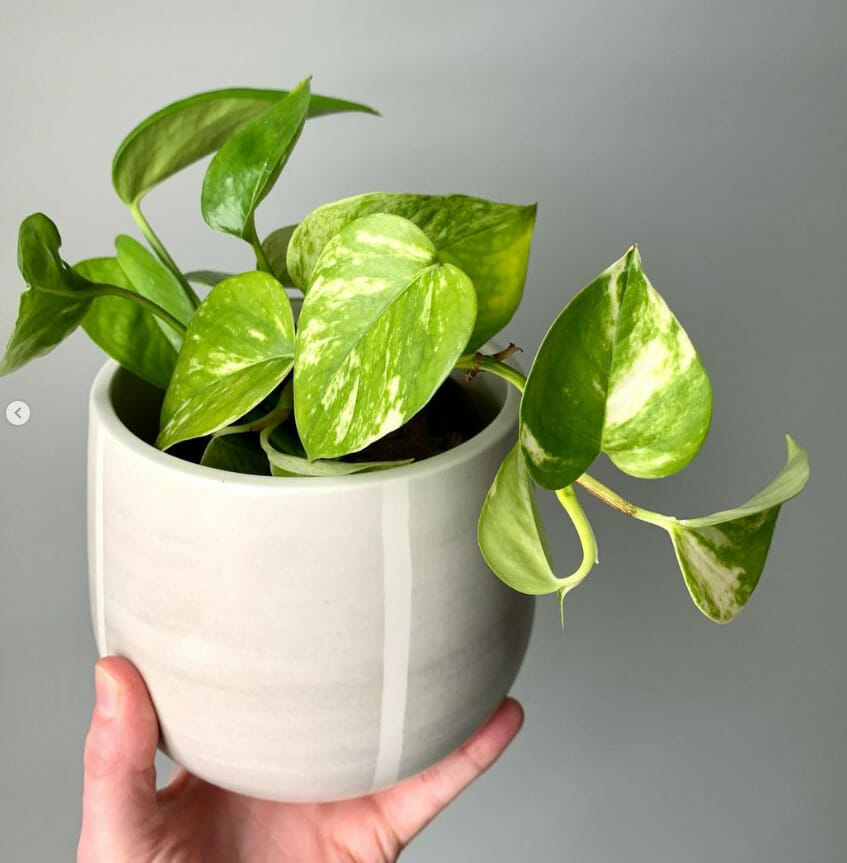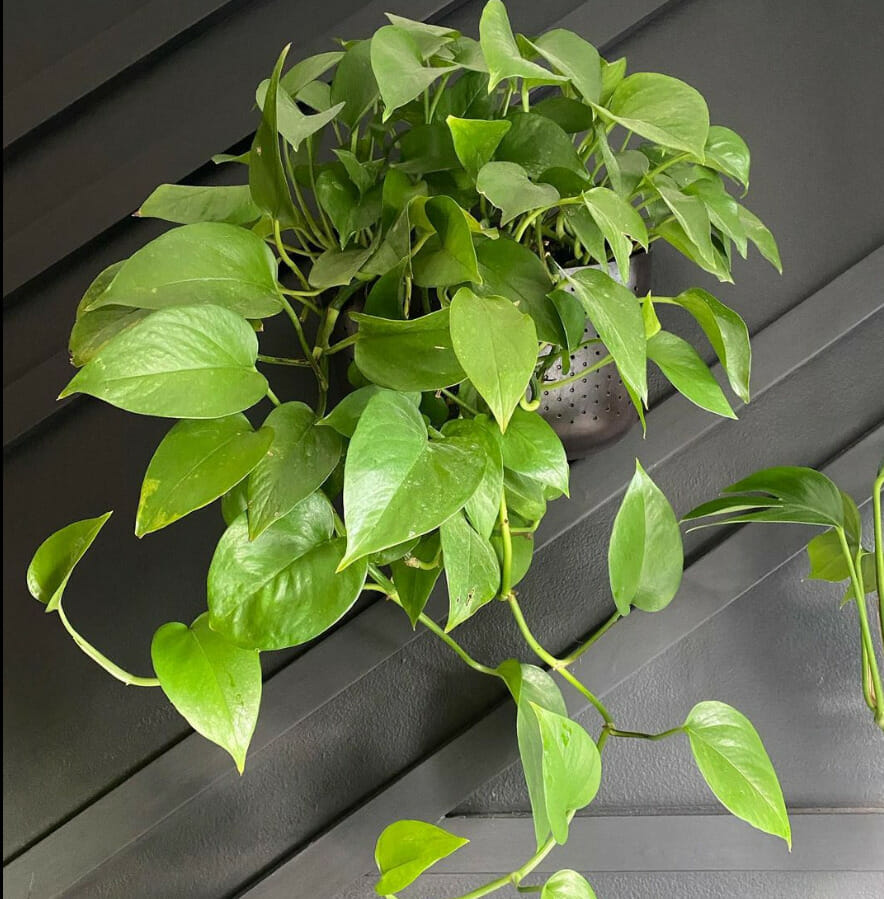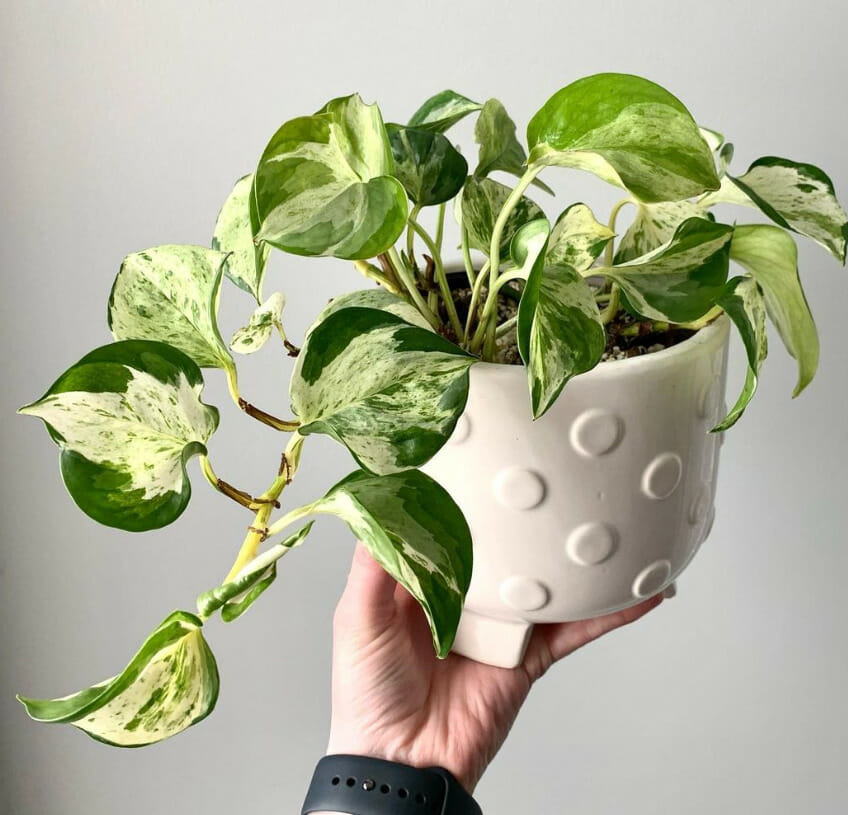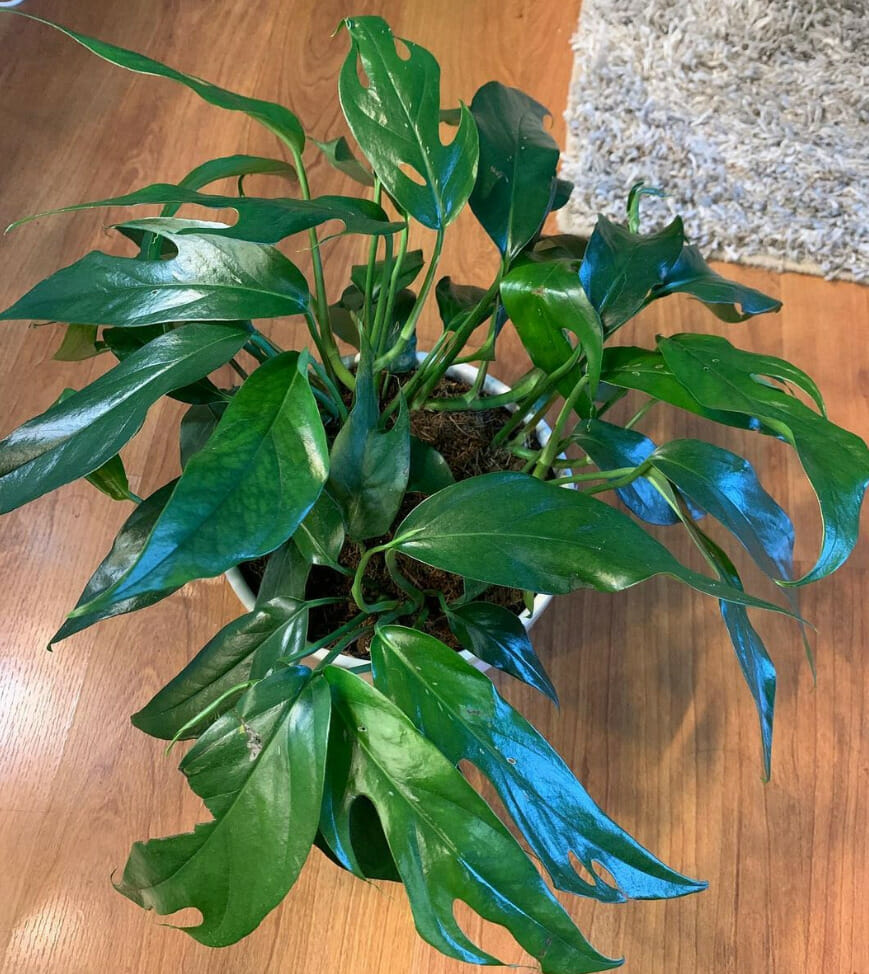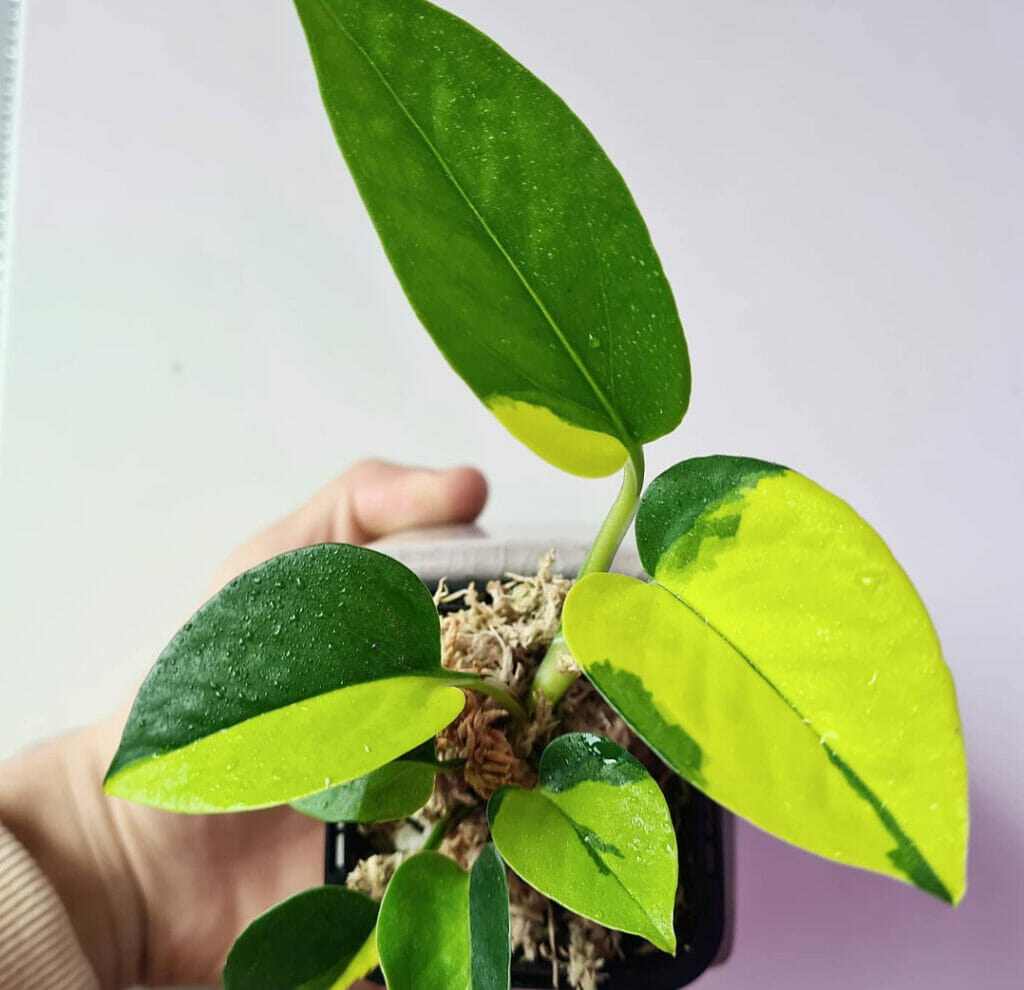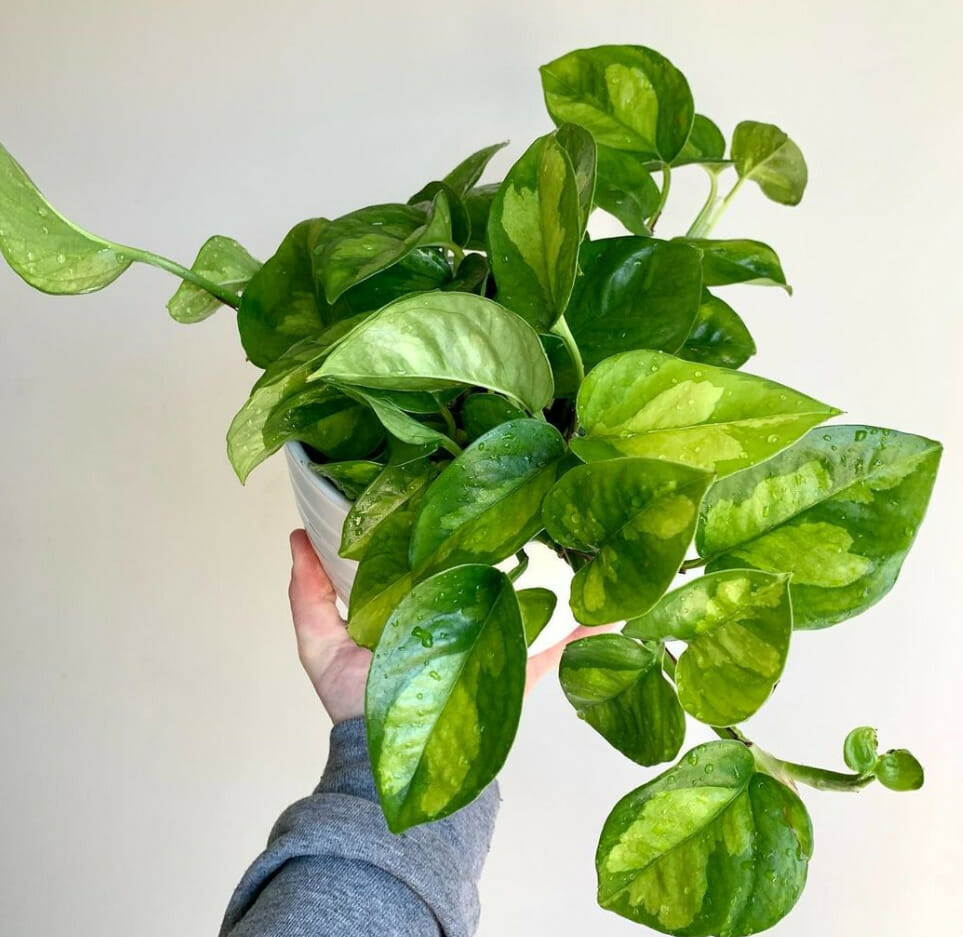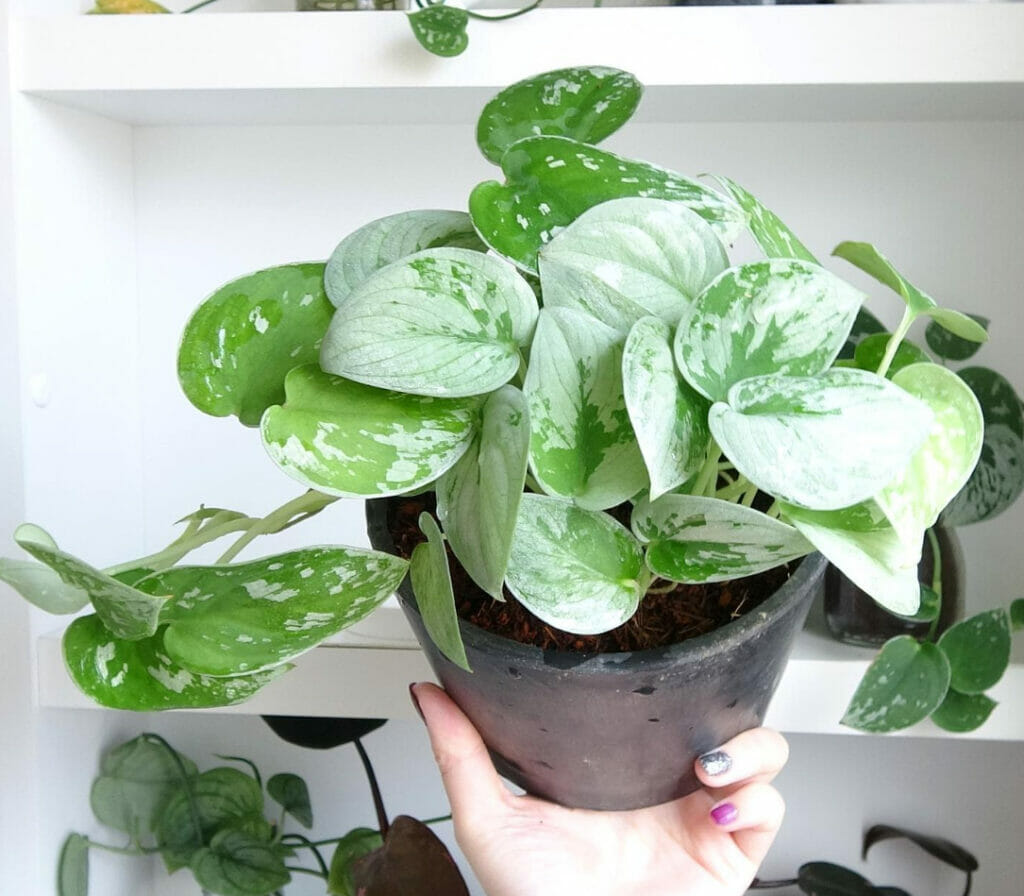Pothos is an evergreen member of the Aracea family. It is one of the most popular houseplants due to its beautiful foliage and ease of maintenance. Native to Southeastern Asia, it can thrive indoors and outdoors. There are different types of Pothos plants that can beautify any indoor space with their trailing stems.
In the wild, only one species, Epipremnum aureum, occurs naturally, but plant enthusiasts have cultivated many other varieties. They share similar traits to the parent plant, varying in the appearance of their leaves. However, all of them can do well in low to medium light conditions with minimal care.
Let’s have a look at 20 beautiful types of Pothos plants that can liven up your house with a touch of nature.

How To Care For A Pothos Plant
Devil’s ivy is a common name for golden pothos. It is quite easy to maintain once you’ve got the basics right, and Pothos is also pretty good at recovery, where it can heal from the worst of conditions.
Here is the starter pack for a newbie Pothos keeper:
Light
Most varieties of Pothos do well in low-light conditions. However, for variegated varieties, a low intake of light may cause the plant to lose its variegation, so a spot close to a window would be an ideal place to keep the plant for a few hours during the day.
Water
The plant requires a moderate intake of water, where it is best to leave the soil to dry before watering it again. Giving it excess water or watering it too often will turn its leaves yellow since the roots will decay in the absence of air.
Soil
Use a well-draining soil mix, as pothos don’t prefer moist conditions. Mixing the soil with coco coir or perlite may enhance these porous qualities and prevent the soil from water logging. Also, use a pot with enough drainage holes to prevent water logging.
Fertilizer
Adding fertilizer once a month will be enough to keep the soil nourished and the plant in good health. Monthly use a diluted fertilizer to add to your plant, where doing so in summer and spring will reap the best results.
Temperature
Normal room temperature will suffice for a pothos, slightly on the warmer side, to allow the plant to thrive. Colder temperatures may affect its growth in the long term, so you might want to keep a check on that.
Propagation
Propagating pothos is quite easy.
- Step 1: First, you need to disinfect the shears or scissors you are going to use to cut the stem. This will prevent your pothos from getting any infections.
- Step 2: Take your stem cuttings right above the root node, where each stem should have at least 3-4 nodes and also a few leaves.
- Step 3: Remove the leaf or leaves right above the root node that you are going to place in the water or soil.
- Step 4: Take the cuttings and place them in a jar of clean water, making sure your leaves stay above the water
- Step 5: Change the water weekly to ensure the healthy growth of your pothos. You should be able to see the roots in a few weeks’ time.
- Step 6: Once the roots are a couple of inches long, put the plant in a pot with drainage holes. Choose a well-draining soil mix to place your pothos and put them in place with plenty of indirect sunlight.
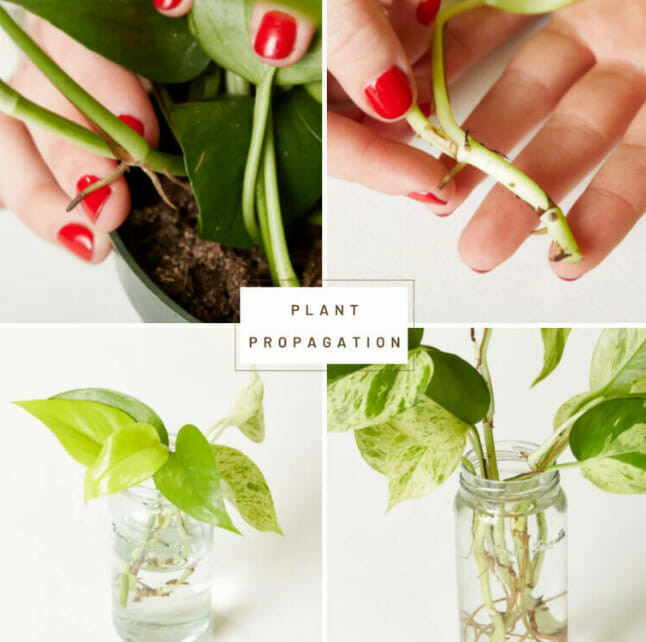
20 Different Types Of Pothos Plants That Are Beautiful And Low Maintenance
1. Golden Pothos (Epipremnum Aureum)
- USDA Hardiness: 10-12
- Size: 40 feet vine
- Leaves: Green foliage with creamy gold variegation
- Growth Rate: Fast
- Light: Low to Medium
This is one of the most common types of Pothos Plants that is widely available in the market. With its heart-shaped leaves, it is a favorite of plant lovers. Due to its patterned, gold variegation through the stem, this species is named Golden Pothos.
It is suitable for different types of light conditions and does well in low-light areas and brightly lit outdoors. The sturdy pigment refuses to fade even in the absence or presence of low light, allowing it to maintain its color and health and making it one of the ideal plants to keep indoors.
2. Marble Queen Pothos (Epiprepnum Aureum “Marble Queen”)
- USDA Hardiness: 11
- Size: Small
- Leaf Color: White and green marble variegation
- Growth rate: Slow
- Light: Medium to bright
Marble queen pothos has a slower growth rate due to plenty of white variegation in its leaves, reducing chlorophyll’s presence. The bright green color of the leaves with the creamy white variegation makes a stunning combination and makes a lovely money plant to decorate your shelves and tables with.
Keep your marble queen pothos in a sunny place if you want to preserve its variegation since it can lose its pattern if left in the dark for too long.
3. Neon Pothos (Epipremnum Aureum “Neon”)
- USDA Hardiness: 11-12
- Size: Medium
- Leaf Color: Bright green (may darken in the absence of light)
- Growth rate: Fast
- Light: Medium to bright
Although there are many types of Pothos Plants, but Neon Pothos has a unique place in the family due to its mesmerizing colors. It is known for its vivid yellow-green, heart-shaped leaves adorning its vines.
You might want to keep your pets away from the plant since it is known to be toxic to cats and dogs. Apart from that, there is nothing to worry about other than the bare minimum because that’s all required to make your pothos thrive, right?
4. Jade Pothos (Epipremnum Aureum “Jade”)
- USDA Hardiness: 10-12
- Size: Medium to large
- Leaf Color: Green
- Growth rate: Fast
- Light: Partial shade
Jade pothos has dark green, heart-shaped leaves with lighter variegation than golden pothos. It has a fast growth rate which may cause its vines to get entangled. You can prevent this by gently shaking them from time to time.
The plant has a tropical origin, so they prefer a sunny habitat with partial shade. However, you don’t want to leave them in direct sunlight because that may leave scorch marks and cause them to dry out.
5. N’Joy Pothos (Epipremnum Aureum NJoy)
- USDA Hardiness: 10-11
- Size: Medium
- Leaf Color: Green with white variegation
- Growth rate: Slow
- Light: Bright, indirect sunlight
N joy pothos shares the same hardy nature as the rest of its species, which is fun to take care of. Another cultivar of the marble queen pothos, N’Joy pothos, has more variegation than its parent plant, while the leaves are smaller and of a solid green color.
6. Manjula Pothos (Epipremnum Aureum “Manjula”)
- USDA Hardiness: 11-12
- Size: medium
- Leaf Color: green with white variegation
- Growth rate: slow
- Light: Bright
Manjula pothos is a rare species in the Epipremnum aureum family. It was cultivated in a lab at a university in Florida. The leaves are quite large, and an interesting pattern flows among the leaves with different shades of green and white streaking the plant, giving it a unique appearance, sure to make a beautiful addition to the rest of your home decor.
7. Snow Queen Pothos (Epipremnum Aureum “Snow Queen)
- USDA Hardiness: 10-11
- Size: Medium to large
- Leaf Color: Green with white variegation
- Growth rate: slow to medium
- Light: bright and indirect
Another lovely addition to the pothos variety is the Snow Queen, which is truly as majestic as it sounds. Just like different types of Pothos plants, it can grow to a nice large size, about 10 ft long, and is often confused with the Marble Queen variety. Snow Queen Pothos Pothos has more white than green, making an interesting pattern throughout the leaves. However, you want to keep the plant in plenty of light, or the pattern will begin to fade.
8. Harlequin Pothos (Epipremnum Aureum “Harlequin”)
- USDA Hardiness: 10-12
- Size: Large
- Leaf Color: Green with white variegation
- Growth rate: Fast
- Light: bright but indirect
Harlequin pothos is quite similar to Manjula pothos, but is more variegated and is much less common than the Manjula variety. You need to be careful when buying a Harlequin pothos since the keeper might be giving you a Manjula in the guise of a harlequin and charging you a higher price, too. The plant prefers a moderate temperature and high humidity levels, although it will survive in lower temperatures.
9. Hawaiian Pothos (Epipremnum Aureum “Hawaiian”)
- USDA Hardiness: 11-12
- Size: Medium to large
- Leaf Color: Green with gold variegation
- Growth rate: Fast
- Light: Bright sunlight
Due to its tropical origin, the Hawaiian pothos thrives at higher temperatures and brightens up your living room with its vibrant appearance. The lush green heart-shaped leaves are capable of reaching large sizes, and the way they grow down a hanging pot or up (with support) allows you to add variety to their outlook, making it one of the most ideal plants to keep indoors.
10. Glacier Pothos (Epipremnum Aureum)
- USDA Hardiness: 10-11
- Size: Medium
- Leaf Color: Silvery green with white variegation
- Growth rate: Slow
- Light: Bright
This dainty-looking plant is a cultivar of the Marble Queen pothos and is often confused with N’Joy and Pearl and Jade pothos. However, one may easily distinguish between the leaf shapes where the glacier pothos leaves are more oval, and the color also differs slightly. Like other plants of the Aracea family, it is hardy but has a slower growth rate as compared to the rest of the pothos plants.
11. Baltic Blue Pothos (Epipremnum Pinnatum “Baltic Blue”)
- USDA Hardiness: 9-11
- Size: Large
- Leaf Color: Dark green
- Growth rate: Fast
- Light: Medium to bright
Baltic Blue pothos is known for the hues of blue in its majestic dark green leaves that can grow to large sizes. However, the blue shade will develop gradually, so you might need to give the plant more time to mature.
Unlike other types of Pothos plants, Baltic Blue pothos is non-toxic but does have a few health hazards, so you still need to be careful when letting your pets and kids near it.
12. Pearls And Jade Pothos
- USDA Hardiness: 9-12
- Size: Medium
- Leaf Color: Green with white variegation
- Growth rate: Slow
- Light: Bright light, every day
Pearls and jade pothos is a cultivar of Marble queen pothos but can be easily distinguished from its parent by its leaves which are thinner, and the variegation pattern is also different. Pearls and jade are also more fragile than the rest of their relatives, so they might require extra care from your side.
13. Variegated Neon Pothos
- USDA Hardiness: 11-12
- Size: Small
- Leaf Color: Bright green with yellow variegation
- Growth rate: Moderate
- Light: Medium to bright
Variegated Neon Pothos is a low-maintenance money plant and a sport of the Epipremnum Aureum. Its acre is easy, and it won’t take much of your time or energy. The leaves are thin and bright green with yellow variegation that gives it a lively, unique appearance.
14. Jessenia Pothos (Epipremnum Aureum “Jessenia”)
- USDA Hardiness: 10-12
- Size: Large
- Leaf Color: Bright green with slight variegation
- Growth rate: Slow
- Light: Bright but indirect
Jessenia pothos is a variegated variety of Marble queen pothos, but the variegation among its leaves is much less prominent than in the queen pothos. You need to be careful with the soil you choose to make your plant grow in, where it needs to be porous but also retain moisture.
15. Global Green Pothos
- USDA Hardiness: 10-12
- Size: Medium
- Leaf Color: green with light green variegation
- Growth rate: moderate
- Light: medium to bright
Global Green Pothos is perhaps one of the most unique varieties you’ll find in the Epipremnum family. The delightful green-on-green variegation it has on its leaves allows it to maintain a bold appearance without compromising on its chlorophyll distribution. Just pick a good sunny spot for your global green pothos and do weekly checks on its water levels, and you’re good to go.
16. Dragon Tail Pothos (Epipremnum Pinnatum)
- USDA Zone: 9 and above
- Size: Small
- Leaf Color: Deep Green
- Growth rate: Moderate to fast
- Light: Bright light
Dragon tail pothos enjoys the status of being a parent plant to several varieties of the Epiprepnum Pinnatum family, including Cebu blue and Baltic Blue pothos.
It may not have the brightest leaves or delicate variegations. However, you’ll find that it is much easier to care for than other pothos plants, where it can even endure a few hours of direct sunlight.
17. Cebu Blue Pothos (Epipremnum Pinnatum “Cebu Blue”)
- USDA Hardiness: 9-11
- Size: Large
- Leaf Color: Blue-green
- Growth rate: Fast
- Light: Medium to bright
The blue-green color of the Cebu blue pothos makes it one of the most stunning and rare varieties of the Epipremnum family. The delicate leaves of slim stature, with undertones of blue, will show a lovely silvery trail under the right light. The appearance of the leaves will also differ depending on whether they are grown indoors or outdoors.
18. Satin Pothos (Scindapsus Pictus Argyraeus)
- USDA Hardiness: 10-12
- Size: Medium
- Leaf Color: Dark green with slight variegation
- Growth rate: Moderate
- Light: Bright
Satin Pothos is a member of the Aracea family and shares most of the characteristics with its cousins. However, their leaves are a bit thinner, and the silver variegation is much less pronounced in this variety, but it is there nonetheless.
It is sensitive to lower temperatures, so the room temperature needs to be kept warm enough with moderate humidity levels in order for the satin Pothos to grow properly.
19. Silvery Ann (Scindapsus Pictus)
- USDA Hardiness: 9-11
- Size: Small to medium
- Leaf Color: Green with silver splotches
- Growth rate: Slow
- Light: Bright and indirect
Silvery Ann is quite similar to Satin Pothos but has more silver variegation. However, it may fade over time if enough sunlight is not provided enough to the plant. Ensure your pothos is getting sunny hours if you want to maintain the lovely patterns on its leaves.
20. Trebi Pothos (Scindapsus Pictus “Trebi”)
- USDA Hardiness: 9-11
- Size: Medium to large
- Leaf Color: Green with silver variegation
- Growth rate: Fast
- Light: Bright
Trebi Pothos is quite a lovely plant with large heart-shaped leaves belonging to the Scindapsus variety, where they have their own distinct silver variegations. Like all pothos plants, the Trebi pothos prefers moist but drained soil. Avoid over-watering the plant since that can damage its roots and kill the plant.
Conclusion
Most of the pothos plants make ideal indoor plants due to their hardy nature and low maintenance. Apart from occasionally monitoring their water levels and making sure they are getting enough sunlight, there isn’t too much to worry about when it comes to pothos plants.
Most types of Pothos Plants are very common, and you’ll be able to find at least one Pothos variety at a nearby nursery or plant shop, so drop your excuses, prepare your gear and be ready to become a plant parent!
If you liked this article, visit our website for more articles on plants.

